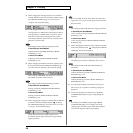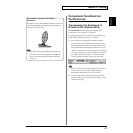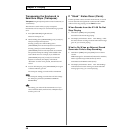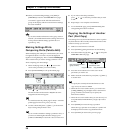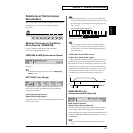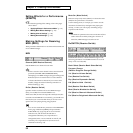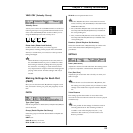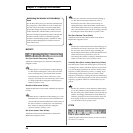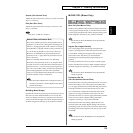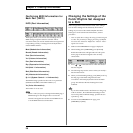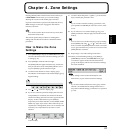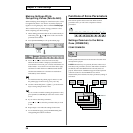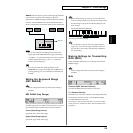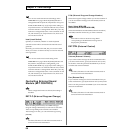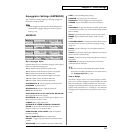
54
Chapter 3. Creating Performances
MODIFY
fig.03-16
Cut (Part Cutoff Frequency Offset)
Adjusts the cutoff frequency for the Patch or Rhythm Set
assigned to a Part.
Patches also have a Cutoff Frequency Offset setting (p.
71). The final Cutoff frequency value is the sum of the
Tone Cutoff Frequency value and the Patch and Part
Cutoff Frequency Offset values. If the Tone’s cutoff
frequency is already set to 127 (maximum), there will be
no change produced by setting the Cutoff Frequency
Offset to a positive value.
Res (Part Resonance Offset)
Adjusts the Resonance for the Patch or Rhythm Set assigned
to a Part.
Patches also have a Resonance Offset setting (p. 71). The
final Resonance value is the sum of the Tone Resonance
value and the Patch and Part Resonance Offset values. If
the Tone’s resonance is already set to 127 (maximum),
there will be no change produced by setting the
resonance offset to a positive value.
Atk (Part Attack Time Offset)
Adjusts the TVA Envelope Attack Time for the Patch or
Rhythm Set assigned to a Part.
Patches also contain the Attack Time Offset setting (p.
71). The final TVA Envelope attack time value is
therefore the sum of the Tone’s TVA Envelope T1
setting, the Patch’s Attack Time Offset, and the Part’s
Attack Time Offset. If the Tone’s T1 parameter is already
set to 127 (maximum), there will be no change produced
by setting the Attack Time Offset to a positive value.
Rel (Part Release Time Offset)
Adjusts the TVA Envelope Release Time for the Patch or
Rhythm Set assigned to a Part.
Patches also contain a Release Time Offset setting (p. 72).
The final TVA Envelope release time value is therefore
the sum of the Tone’s TVA Envelope T4 setting, the
Patch’s Release Time Offset, and the Part’s Release Time
Offset. If the tone’s T4 parameter is set to 127
(maximum), there will be no change in the Release Time
Offset, even when this is set to a positive value.
Velocity Sens (Part velocity Sensitivity Offset)
This changes the volume and cutoff frequency for each part
according to the velocity with which the keys are pressed. If
you want strongly played notes to raise the volume/cutoff
frequency, set this parameter to positive (+) settings. If you
want strongly played notes to lower the volume/cutoff
frequency, use negative (-) settings. Set Velocity Sensitivity to
0 when you want sounds played at a fixed volume and cutoff
frequency, regardless of the force with which the keys are
played.
Patches also contain a Velocity Sensitivity Offset setting
(p. 72). The ultimate Velocity Sensitivity Offset value is
the sum of the part’s and the Patch’s Velocity Sensitivity
Offsets. Accordingly, if the Patch’s Velocity Sensitivity
Offset T1 parameter is set to 127 (maximum), there will
be no change in the part’s Velocity Sensitivity Offset,
even when this is set to a positive value.
PITCH
fig.03-17
Octave (Part Octave Shift)
Adjusts the pitch of the Part’s sound up or down in units of
an octave (+/-3 octaves).
Calculating the Number of Voices Being
Used
The XV-88 is able to play up to 128 notes simultaneously.
The polyphony, or the number of voices (sounds) does
not refer only to the number of sounds actually being
played, but changes according to the number of tones
used in the Patches, and the number of Waves used in
the tones. The following method is used to calculate the
number of sounds used for one Patch being played.
(Number of Sounds Being Played) x (Number of Tones
Used by Patches Being Played) x (Number of Waves
Used in the Tones)



